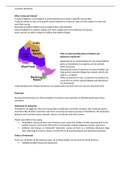Class notes
Common Mammals in Ontario
- Institution
- Durham College ( )
Incredibly detailed notes about mammals, with specific focus on common mammals in Ontario. Includes habitat, classification, animal size, range, appearance, food sources, reproduction, similar species, latin names, and interesting facts.
[Show more]



